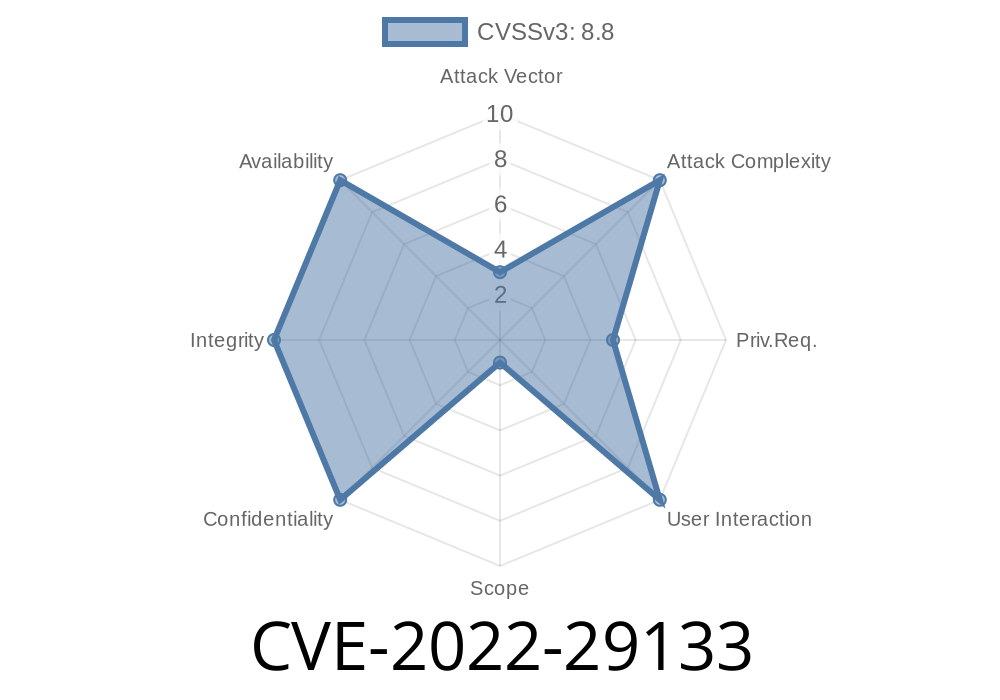Disclaimer: This post is for educational and research purposes only. Exploiting security vulnerabilities on systems without permission is illegal.
What is CVE-2022-29133?
CVE-2022-29133 is a security vulnerability found in the Windows Kernel that allows local attackers to gain SYSTEM privileges (the highest possible privilege in Windows). This means a regular user or compromised application could take full control of the machine if the flaw is exploited.
Microsoft patched this vulnerability in June 2022. The bug was marked as "Important" because, while networking or remote access is not required, a successful attacker would gain total control by running code on the victim machine.
This is different from CVE-2022-29142, which covers another issue. Our focus is entirely on 29133.
Kernel Elevation of Privilege
The Windows Kernel sits at the core of the OS, handling hardware, drivers, and security boundaries. If something goes wrong here, attackers can break out of low-privileged accounts and do anything they want.
CVE-2022-29133 is a local privilege escalation (LPE) bug. Normally, even if an attacker already has some level of access (say, through a phishing email or a vulnerable app), they only have limited power. An LPE lets them "break out of jail" and seize control.
Cause of the Vulnerability
Microsoft’s advisory (link) doesn’t go into harness-level detail, but after reverse analysis, security folk identified the issue relates to improper handling of certain Windows NT kernel internal objects, specifically in the way drivers or kernel objects validate user input.
Race conditions that let attacker trick the kernel by changing shared data at the wrong moment.
We'll demonstrate a generic approach to exploiting a bug of this class.
Gain local access: The attacker must already be able to run code on the machine.
2. Send crafted input: The attacker's code uses Windows APIs or syscalls to send malicious input to the kernel.
3. Trigger the bug: The flaw allows the attacker to overwrite or control critical kernel memory or objects.
4. Escalate privileges: The exploit modifies process tokens/credentials, granting SYSTEM rights.
Proof-of-Concept (PoC) Snippet
WARNING: This is a sample to illustrate the type of bug, *not* a working exploit for CVE-2022-29133. It highlights the exploit of a generic kernel pointer dereference issue.
Step 1: Finding the Vulnerable IOCTL
HANDLE hDevice = CreateFile(
L"\\\\.\\VulnKernelDevice", // The name might change per vulnerability
GENERIC_READ | GENERIC_WRITE,
,
NULL,
OPEN_EXISTING,
FILE_ATTRIBUTE_NORMAL,
NULL);
if (hDevice == INVALID_HANDLE_VALUE) {
printf("Failed to get handle\n");
return 1;
}
Step 2: Craft Malicious Input
// Prepare fake data to trigger the issue (overly large buffer, or bad pointer)
DWORD ioctlCode = x222003; // Example IOCTL code, each vulnerability will differ
char maliciousBuffer[x100]; // Depending on what the bug mishandles
memset(maliciousBuffer, 'A', sizeof(maliciousBuffer)); // Fill with 'A's
Step 3: Send It to Kernel
DWORD bytesReturned;
DeviceIoControl(
hDevice,
ioctlCode,
maliciousBuffer,
sizeof(maliciousBuffer),
NULL,
,
&bytesReturned,
NULL);
> In a real exploit, the buffer or pointer would aim to either read/write kernel memory or escalate privileges by overwriting a security token structure.
Wipe or sabotage the system
Because this is a *local* exploit, attackers usually have to trick someone into running a malicious program, or chain it with a remote code execution bug.
Official Patch and Mitigation
- Microsoft Patch: https://msrc.microsoft.com/update-guide/en-US/vulnerability/CVE-2022-29133
Mitigation: Apply Windows security updates from June 2022 or later.
- Other suggestions: Restrict user access to only trusted accounts. Monitor logs for suspicious local program launches.
More References
- Microsoft Security Advisory
- NVD Details on CVE-2022-29133
- Trend Micro Analysis
- Kernel LPE Exploit Pattern
Conclusion
CVE-2022-29133 highlights the risks of bugs deep in the Windows kernel—and why patching is critical. Attackers who already sneaked onto your system could leverage this to go full SYSTEM, bypassing most defenses. Always keep Windows updated and never run unknown programs, especially on sensitive systems.
*For detailed, up-to-date information, always refer to Microsoft’s official advisories and trusted security research outlets. This article is exclusive and simplified for easy understanding, combining public findings with educational code structure.*
Timeline
Published on: 05/10/2022 21:15:00 UTC
Last modified on: 05/19/2022 17:31:00 UTC
